www.patrickgrant.com
nEWS
01 JAN 09
hAPPY nEW yEAR!
Rio Wrap Up
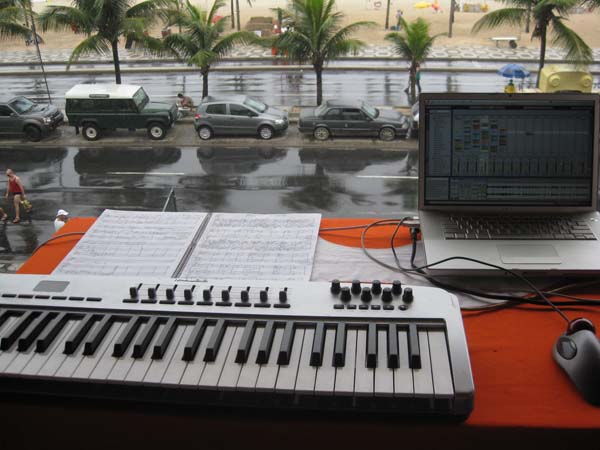
The view from the terrace at the Casa de Cultura Laura Alvim on a rainy day (?) in Ipanema
Intro:
What a sTRANGE month it has been. I had barely just returned from three weeks in São Paulo in early November and found myself bound for Rio de Janeiro in early December. The seeds for this particular trip were planted while still in SP when Gerald Thomas introduced me via email to the genial Gustavo Ariani, director of the drama school CAL – Casa das Artes de Laranjeiras in Rio. Gustavo had just brought down to Rio Judith Malina, of the Living Theatre, to accept an award given by the Brazilian government and to give workshops at his school. Gerald said that I should propose my workshop in Theatre Sound Design & Composition to Gustavo for early January which got the whole ball rolling.
I soon found out that nothing that is in the arts in Brazil has a single sponsor. They often have many sponsors. Many many. To make this new trip possible, Gerald also wanted to have me on board as the composer for his new piece Bate Man which was scheduled to premiere on December 12th and that threw another sponsor into the mix. In addition, Gustavo hooked me up with the 9th annual riocenacontemporanea festival to give a concert on Ipanema Beach no less. So, these three possibilities of work in Rio became immediate. Two NYC projects that I had been counting on upon my return from SP had fallen through/been postponed due to the recent "economic downturn." That meant if any $ were to be made in December, it'd have to be made in Brazil. In turn, I'd have to move a mixing project and my work on MC Larry Trevelyn's Apeirophobia into January and get myself together for three heavy-duty weeks of cranking out some new music.
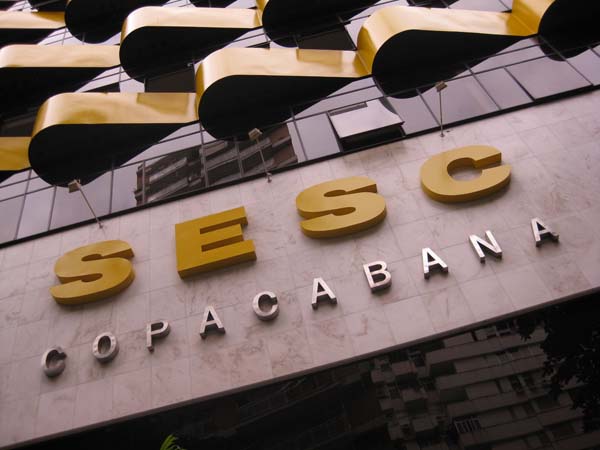
SESC - Copacabana: all that and no internet...
Arriving in Rio on a Saturday morning, Gustavo picked me up at Rio's airport and the next thing I knew I was having a coconut water with him on Ipanema Beach looking at the Casa de Cultura Laura Alvim (photo below) where I'd be giving my concert in nine days. Then I checked into what would be my home during the stay, the internet-less SESC - Copacabana. I'm still not exactly sure what a SESC is because they themselves are made up of so many sponsors (and was relieved to find out that most Brazilians weren't exactly sure either) but they are all around Brazil, the bigger cities having more than one, housing offices, spaces for workshops and events, are party hotels, and in my case, are home to a number of theaters on the lower levels. So, I was staying in a room nine floors about the theater in which Bate Man was to be rehearsed and premiered. I was one block away from Copacabana beach at and all of the touristy lojas (shops) that one would expect to find.

From the riocenacontemporanea web site: http://www.riocenacontemporanea.com.br
Week 1:
This would be a very heavy week by anyone's standards and almost 90% involved with the creation of the Bate Man score. After checking into SESC, unpacking and having a shower, Gustavo picked me up and we went to Gerald's hotel to get him. He had arrived there two days before and had already adjusted to the 3-hour-ahead time difference. From there we went to the space of the Cia. dos Atores, the group which had commissioned the piece, a monologue, for one of their actors, Marcelo Olinto. The company was celebrating its 20th anniversary and to do so they created a program called Auto-Pecas, a series of one-person pieces for all of their lead actors. Their rehearsal space/theater is in the neighborhood of Lapa, a little bit up on the colorful hand-tiled folk-art steps that lead to Santa Teresa. We would rehearse here for two nights before moving into the Teatro de Arena at SESC - Copacabana on Monday.
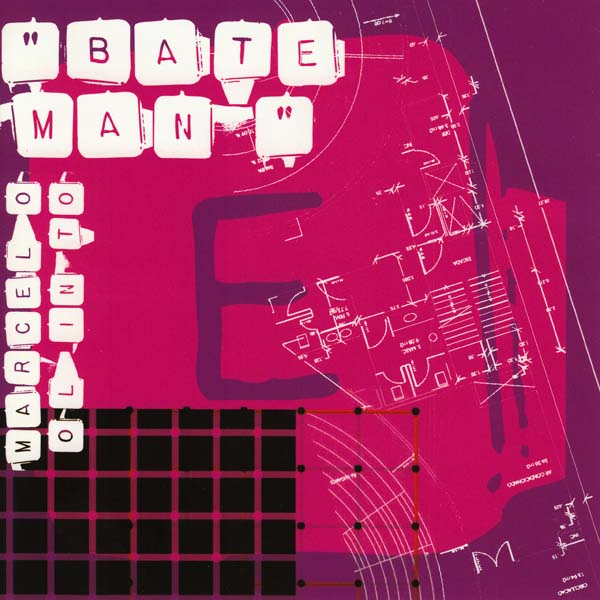
The front of the card that Cia. dos Atores had made for Bate Man
So here I was, without sleep (the plane was impossible) on my first night and first rehearsal in Rio. Coming into the Cia. Dos Atores' space I just said hello to everybody knowing full well that I was in no condition to remember anybody’s name and began setting up. Based upon my recent work on the road I had been relying on my Macbook Pro powering Ableton LIVE 7, Reason 4.0, and Pro-Tools. I also had two external drives with me containing all of my sound FX libraries and just about my complete catalog of recorded music. A 4-octave M-Audio USB MIDI keyboard completed the picture.
There at the soundboard, I met Rodrigo Marçal, who along with Lucas Marcier (whom I’d meet later), were the regular composer/producers of the company. I was relieved to see that Rodrigo had an almost similar set up to mine, meaning, that if any technical concerns were to come up that I had two talented guys close by that spoke my language (literally and figuratively) and that there’d be technical back-up if needed.
All that existed of the score at this point was a temp cue that Gerald suggested from the James Bond film Goldeneye which he had seen recently on cable (and of which I had found on torrent and ripped the DVD audio from) and five tracks of electric guitar solos that he had recorded the day before over some Led Zeppelin beats with Rodrigo. Both Gerald and I had been using electric guitar in our recent work (he in Kepler, the Dog and I in Eureka! and Complexo Sistema) so it was a natural meeting of minds at the timbral level to continue to do so in this piece. Rodrigo had put them into Logic Studio 8 and he told me which of the tracks was the preferred one but I was too tired to remember. I could see that the rehearsal was going to be a baptism by fire.
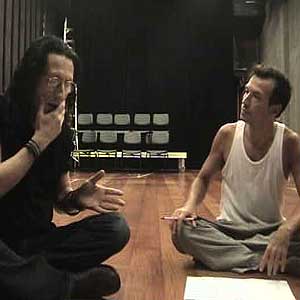
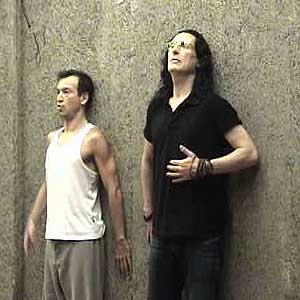
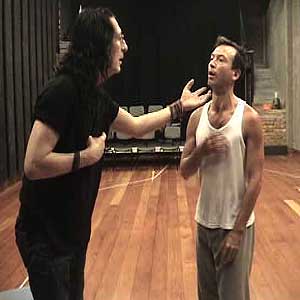
Gerald had so many concerns with the actor Olinto he thankfully let me do my own thing. I have so much experience following actors with improvisation, I jumped right in as they were already doing run-throughs-with-stops of the piece. I didn’t worry about melodies and harmonies at this point, as I often don’t, and concentrated on the structure and the feel of the piece, trying to find the natural breaks in the text that weren’t immediately apparent. As I did this, Gerald followed Olinto around the space directing him with one hand while the other hand was reserved for me, raising it up and down like a conductor, cueing when to start, when to stop, when to crescendo and diminuendo. This method always works great and Gerald does it very well.
I learned the piece quickly, the structure of it that is. The language barrier of the Portuguese still had me guessing at the exactness of the beginnings and ends of the cues but that would come later since I like working from the macro to the micro when I'm working this quickly. Rehearsal ended in a blur as I was really tired now and I could only hope that my reptilian brain was able to absorb and retain as much of what had happened as possible. Rodrigo burned me the electric guitar solos as a Logic session right onto my key drive, I packed up, and Olinto’s physical trainer, an incredibly nice yoga instructor named Daniela Visco drove me back to SESC – Copacabana where I fell into a deep, deep sleep. Dani Visco was to become my friend and even lent me a yoga mat to during my stay so I could do my morning routine and to help me prevent any ossification of my body from taking place while sitting at my desk putting this and the other shows together.
The next day set the rhythm upon which I was to exist for almost the entire stay in Rio: 1. Get up for the 7 AM breakfast 2. Check my email at the internet café around the corner 3. Create and record the new tracks for the day 4. Go to rehearsal 5. Get back to my room, edit a few things based on how the rehearsal went 6. Go to sleep and repeat the same routine the next day and the next day and the next day 7. Rinse, lather, repeat.
I couldn’t remember which of the electric guitar solos Gerald had recorded that was the one that Rodrigo had been using so, I decided to use them all simultaneously, panned across the stereo field. I liked its feel and better yet, the idea of it. Since the show opens with the character of Bate Man being tortured, I added in some whips from the BBC Sound FX library that I had edited together. That became the first real temp track that I made there and it worked well in rehearsal though I’d re-record my originall version of it in a day or two later once I roughed out some more sections.
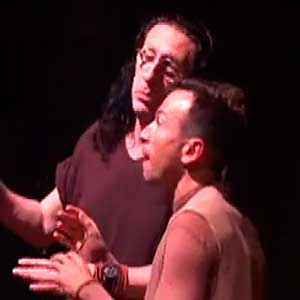
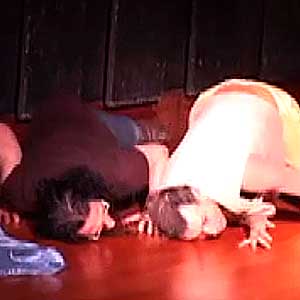
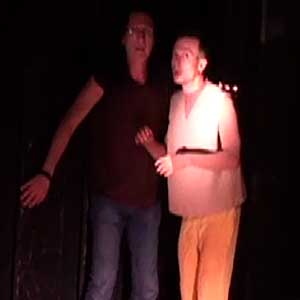
The next rehearsal was a repeat of the night before except that I made sure that the ever-present videographers did a special taping of the run-through for me to take back, convert to a Quicktime movie, and use as a reference during the next few days as I worked alone in the hotel room. When one is working this quickly, I had learned from Eureka! and Complexo Sistema that this is the way to go. Rehearsals are rehearsals but it is the time spent between them that I do my real work and these videos are so helpful for the timing of each scene and how I can pace the musical elements, transitions, harmonic and rhythmic movement and such.
I’m also lucky that Gerald trusted my process. The lesser talents that I’ve sometimes worked with get nervous and panic because they can only hear what they hear. The bigger ones have the intuitive inner ear that fills in the blanks where the notes will eventually go, the ones that I hear in my head while I’ve got bigger fish to fry like the structure of the piece and the other smaller frameworks upon which they’ll ultimately find place. Consider also how much Gerald and I know each other as people, how we think and what we know we already like and that in itself cuts down on so much talk. When it comes to music, I’ve met a lot of collaborators who can overtalk their needs before a single note is even played whereas it’s always quicker and more fun to try out a string of ideas, keep the ones that work, reject the ones that don’t (no big deal), and keep moving forward.
By now we had moved the operation in the theater at SESC. So many new faces, I didn’t know who was who. It seemed that everybody I met was a “producer,” everybody, that is, who didn’t have something concrete to do that I understood as being theater. Many sponsors meant many producers I soon figured out. Still, the concrete things did get done. Lights were going up care of Gerald’s long time collaborator, the ever-so-smooth Caetano Vilela, the set was being built with the help of the technicians from the Cia. Dos Atores, and I was working away during the day nine floors above.
That last factor took the edge off my set up time and let me often, very often, work right up until the minute that I had to go downstairs. A few times I even came down in the elevator (no doubt one of the slowest I’ve ever had the displeasure to know) with my laptop in hand, it bouncing down tracks on battery power, its screen still in the upright position. A little hectic to be sure but, at this pace, every minute counted.
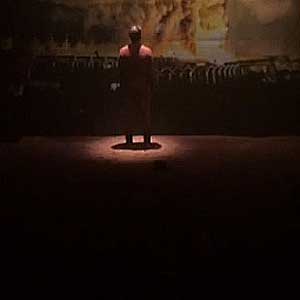

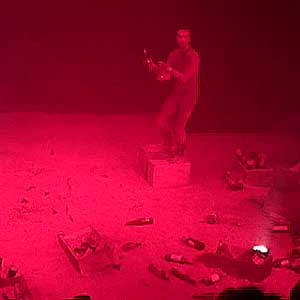
Rodrigo and Lucas were kind enough to let me borrow one of their studio’s guitars during my stay, a Brazilian Giannini, a copy of a Les Paul SG that did the trick. More and more the main music of Bate Man was becoming a multi-tracked ensemble of electric guitars playing over western classical instruments and rhythmic synthesizer textures. I decided to keep any percussion to a bare minimum so that the instrumental parts themselves would have to be created and played in a percussive way to compensate. Plus, it would keep the score from sounding too much like popular music and more as the post-modern take on it (as a sonic semiotic) that it was intended to be.
The sound demanded sub-woofer speakers and man, did I have to fight for them. I finally got them (with Gerald’s insistence) and whoa, the music was sounding good thanks to the Cia.’s sound tech Ricardo. Detroit was in the house and rock 'n' roll (or what was passing for it) was in the air. With two days to go at this point, the score was shaping up, I looked a bit ragged but had a smile because it was all coming together. And, I always like to save my "victory shaves" for opening nights.
Now, it must be said that there was a whole lot of peripheral inter-personal stuff going on while I was keeping to my production schedule with my daily trips to the juice stand for my beloved açai na tijela com banana batida or the glorious food-by-weight rodizios as my only change of scenery. Gerald was having grave problems with the production company (or companies as it seems to go down there) as well as getting the actor Olinto where he wanted him performance-wise. Oh yeah, there was fireworks going off but I was so grateful that what I had to do was clear and that I knew what it’d take to do it and I didn’t step off that path into any of that mess. In fact, Gerald’s and my work relationship was just great and if anything was brought away from this experience it was the inspiration for what we wanted to do in our future work. That in itself could not have been a better result than anything we could have hoped for over any short term success.
At this point, I will leave any further detail of the score’s creation to the notes I have written to the future operators of the music & sound of Bate Man in a document that can be found HERE.
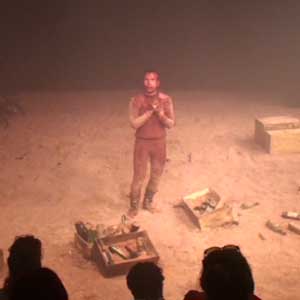
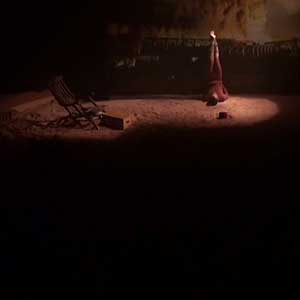
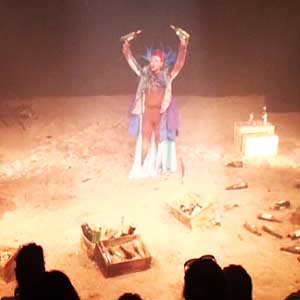
Opening night came. It was a very full house. Gerald heckled the audience and the producers before the show. I loved it. I ran the sound and would continue to do so for the entire run here in Rio. This was because it is not an easy show to run and because it’s not a show that can be played on CD alpne. It’s done in LIVE 7 so it, and like all of my recent shows, requires not only a DJ’s technique and a musician’s sense of timing but also a very sensitive ear that relies upon years of theater experience and the mixing of music on-the-fly with live dialogue. It was all I could do to put it together in the timeframe given, and it was hard for me to imagine me teaching it to someone while I was still refining it and bringing in better mixes each performance. Even after opening night it would evolve.
But the real reason why I ran all the shows is that, even after all these years, I really love doing it, especially now that the technology is as interactive as it is and that it keeps me just as much a performer as anybody out there on the stage.
Afterwards, Gustavo Ariani, his friend Raphaelo (a German ex-patriate with interesting ideas on creating a foundation to preserve theater music), and Gustavo’s daughter all dragged my tired ass out to Lapa to celebrate after the show. I was so exhausted after maling this deadline. What had seemed like a bad idea to me at first quickly turned great in the lively streets of a Friday night and more especially in the chill environment of Nova Capela, Lapa's oldest restaurant at 105 years old, where my attitude was quickly adjusted by the best fried chicken with garlic that I’ve had since I could remember along with some bolas de aipim, fried balls of mashed yucca stuffed with cured and dried meat which I dipped in hot pepper oil. Caramba! The best meal I’ve had in six days, since Gerald had taken me out to Gero, Rio’s best Italian restaurant, the Sunday before. Two memorable meals which culinarily bookended all of the work described above.
Not bad for being here less than a week.
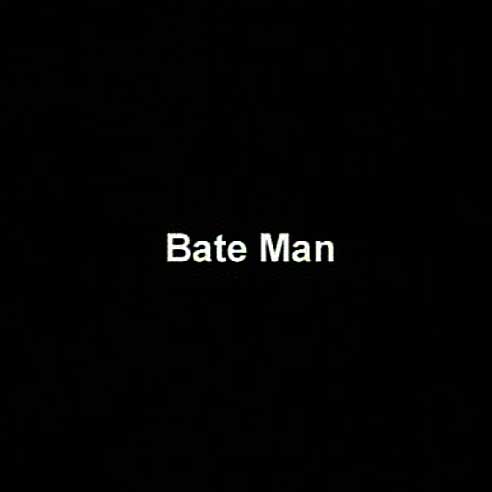
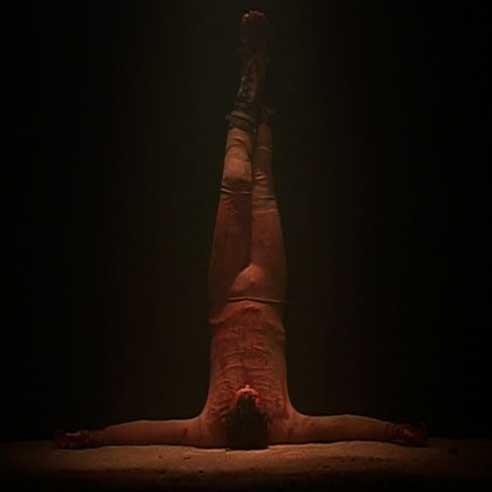
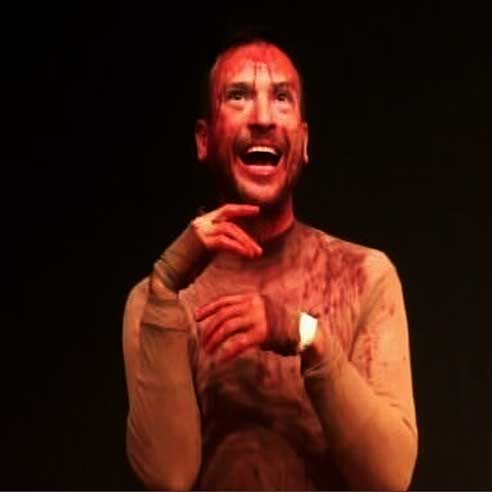
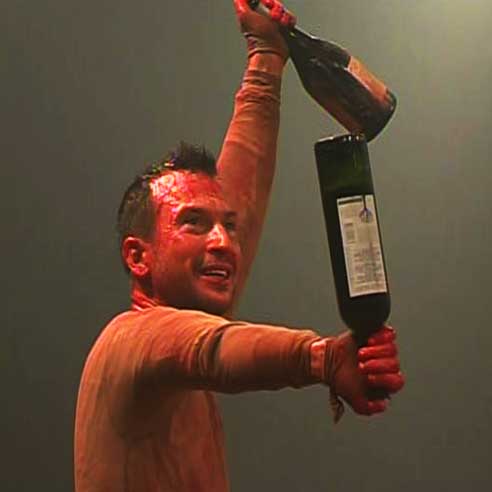
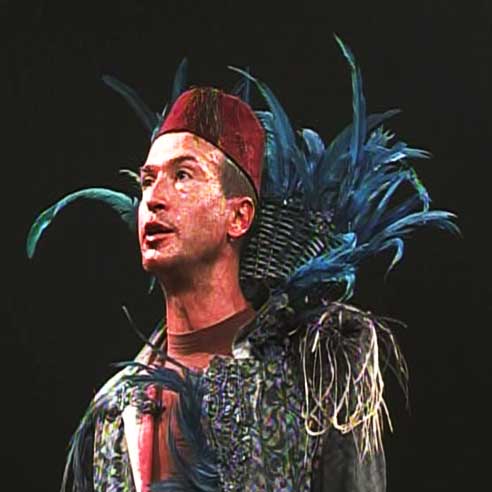
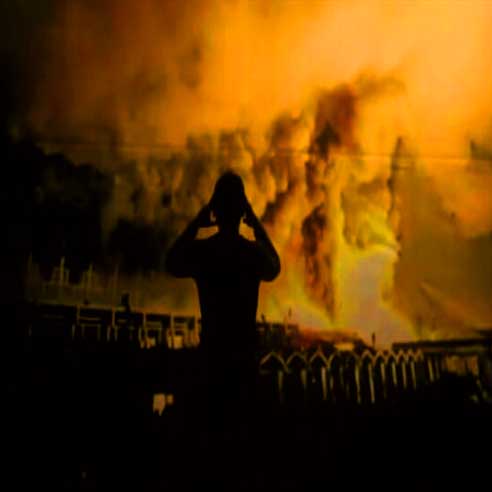
Marcelo Olinto in Bate Man. Photos taken from video
Week 2:
Part 1 - The Concert at the Casa de Cultura Laura Alvim
In order to describe the second week in Rio (my weeks there beginning on Saturdays) I’ll have to backtrack to NYC and the days before I left for Brazil.
One of the sponsors of my trip was the riocenacontemporanea festival. This was to be their 9th annual festival and due to organizational changes earlier in the year, it seemed amazing that they were able to have it at all. One of the three people behind this rebooted festival was César Augusto, also one of the actors and founders of the Cia. dos Atores. What a great man he is for helping to set this up for me (not to mention the entire festival) It was to take place on Friday through Sunday, December 12th to 14th. I had met him only in passing and through email the week of creating the Bate Man score, but I was to get to know him better later in my stay.
The festival was taking place at the Casa de Cultura Laura Alvim, a landmark-status private-residence turned cultural institution that is nestled between the high-rise apartments directly across the strip that bordered Ipanema Beach. The team here was responsible for hiring the visual artists that created all of the fine visuals that were used to promote the festival, my concert, and the workshops I was to give at SESC. I found out later that these graphics people, RADIOGRÁFICO, shared a building that houses ARPX, the studios of Rodrigo Marçal and Lucas Marcier, just another example of how all artists are interconnected and rely on each other everywhere.
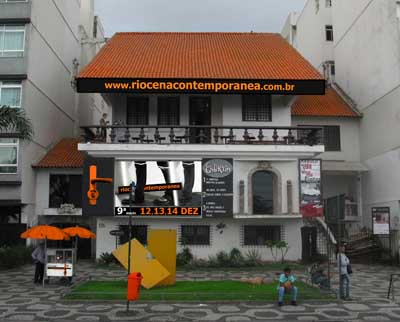
The Casa de Cultura Laura Alvim on Av. Vieiro Souto in Ipanema
In NYC in the days leading up to my departure, and indeed up to the very morning of my flight, I was opening up and saving every sound file of mine possible that could be usable in my concert. Normally, my music is written for ensemble and this concert at the Casa Laura Alvim was an opportunity for me to augment my solo repertoire, in this case, as a DJ style performance using clips and instrumental tracks from my catalog with some live keyboard thrown in. Knowing that the first week would be as tight as it was with Bate Man, I was wise to get all of this done before I left.
However, I didn’t want to nail down exactly what I was going to perform until I had spent some time in Rio where I could get a sense of the scene and decide what would be the appropriate show to do. That meant that I truly had to bring everything possible that I could cram onto my external drives. Much of it did not get used but hey, you never know. Much of that prep work also included extracting bass lines and drum tracks from mixes, isolating string parts, horn lines, etc. because as the technology currently stands, I’m free to make real time mash ups using elements from any number of pieces thereby creating brand new works right in front of the public's eyes, or ears in this case.
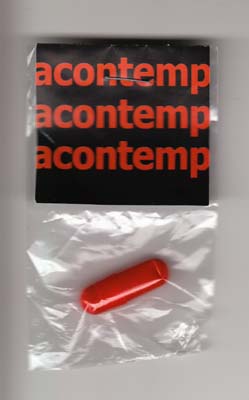
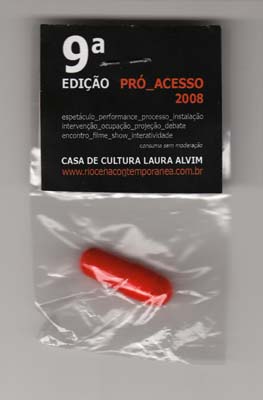
One of the many promotional items made for the festival
So, fast forwarding to the present, this brings us back to the the Friday night opening of Bate Man and the after show mini-celebration in Lapa at Nova Capela. We did make one stop that night before going there and that was to the Casa Laura Alvim to catch the very end of the riocenacontemporanea opening night party. There I was able to properly meet the event organizers, César Augusto whom I’ve mentioned, Bia Junqueira, and Márcia Dias. Also it gave me an opportunity to see the space at which I was to perform in less than 48 hours time. Unfortunately the balcony was closed for the evening, it was late, but it was important to meet and thank the people who got me there. Then it was onto Lapa as described above.

César Augusto, Bia Junqueira, and Márcia Dias
Saturday morning arrived and, after my usual breakfast and email check, I was back in my room putting things together. It was a rainy day and perfect for that kind of work. It’s always a drag to work during the day when it’s outrageously gorgeous outside. Little did I know that this was just the tip of the meteorological iceberg for the days ahead.
Having a sense now of what I’d like to do, I began putting together the elements of my solo show in performance order. I also had the new music from Bate Man that I could incorporate as well as some music from Complexo Sistema. I figured that it would be good to include as much of the new music that I had created in Brazil itself as part of the show alongside some “greatest hits” and other tracks that would be perfect for the time and space. The day flew by, there’s never enough time, and soon enough I had to switch modes and get ready for that night’s performance of Bate Man in the theater downstairs.
I did some remixes of a few sections (I was to spend the entire run of the show tweaking little bits here and there throughout my stay, that’s how I do it) and ran the show. It was another good performance that began once again with Gerald poking fun at, and with, the audience. Good stuff. It was also to be the last performance that he would see in Rio. He was scheduled to fly to Sâo Paulo the next night and to stay a day and continue onto NYC, after my concert and after a showing and discussion of the video to his Blognovela: Kepler, the Dog, also at Casa Laura Alvim and as one of the closing events of the riocenacontemporanea.
I’ve been doing this kind of balls-to-the-wall, deadline-making music creation for so long now that I know how to pace my energy level and adjust my schedule accordingly to hit the mark and, this situation, the whole Rio trip in fact, was no exception. After the Bate Man performance, I declined the after-show dinner (I do regret missing this one with Gerald and César, but I had to), and went straight back to my room with a thermos of coffee that I swiped from the green room. I set my cell phone alarm clock to 3 AM and went straight to sleep, not hard to do since I was pretty tired. When the alarm went off, I got up, poured some coffee, fired up my two laptops )I had also brought a Sony Vaio for audio editing) and finishing the tracks and placing them into a LIVE 7 session that I'd run the show from.
I could hear it raining outside. Hard.
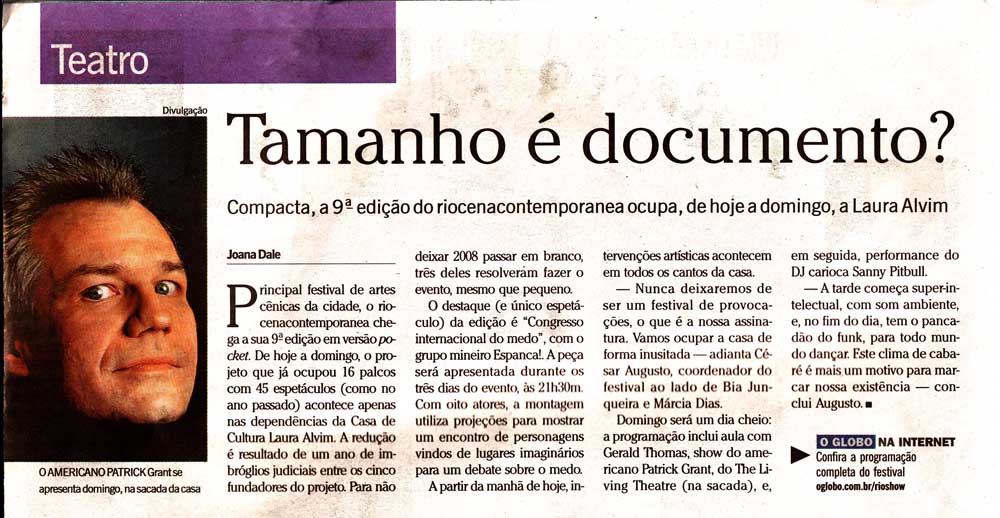
From the O Globo - Rio Show weekend magazine, Dec. 12, 2008. Of all the photos I send out, everyone seems to prefer this "Sonic Hedgehog" pic that Andrew Marks took.
I finished just before 12 noon, took a shower, packed up to be ready for Gustavo when he picked me up at 1:30. I was a little ragged, sure, but I was in high spirits and excited about the show. The only drag was that it was still raining. Hmmm. Not the best thing for a beachside gig. Hopefully it would clear up?
At the Casa Laura Alvim, the riocenacontemporanea festival was in full swing and we went upstairs to begin setting up on the balcony. They had good technicians and a really great sound system. I set up my equipment and saw that I would be listening to myself through two monitors set up on the balcony next to me. Downstairs, the system ran to two sets of speakers and sub-woofers that were worthy of any outdoor concert I ever attended. Man, they were HUGE and had a sound to match. BUT, the rain was still coming down and showed no sign of letting up. Sure, there were some beach creatures out there but definitely not the crowd that would normally be therw and not the crowd that the excellent press the event received in O Globo would be expected to attract. Professional that I am, I had no choice but to keep moving ahead and prepare for a killer concert nonetheless.
Meeting up with us on the balcony was Adriana Figueirdo, a filmmaker who lives in Rio. I met Adriana on Nov. 9th in NYC at the Living Theatre. I had just flown in that morning from Sâo Paulo having finished my work there on Complexo Sistema, the piece by Ruy Filho that I scored. It was the last performance of Eureka! and I wanted to be there at that show to take my bow with Judith Malina. Adriana had videotaped Judith’s recent workshop at Gustavo’s theater school CAL that I mentioned above a few weeks before. I was introduced to her by longtime LT member Ilion Troya, himself a Brazilian from SP and living in NYC for some decades now. We hit it off and before she returned to Rio, she stopped by my apartment with Ilion and taped an hour of me discussing the music to Eureka! and showing the techniques that I used in its performance on the equipment in my studio. How good that was to have somebody so curious about that aspect of the work. Not too many people do. I think that most folks take music for granted these days since we have had recorded media for the last 100+ years and that it sometimes diminishes their realization that this music is indeed original and is created for a specific theatrical purpose.
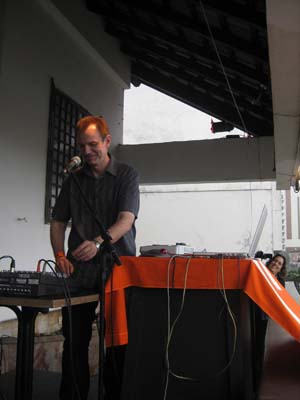
On the balcony with Adriana in the background
During that interview/demonstration I had stressed how much of the music I love and perform is music of ceremony. Whether it’s Bach cantatas, music in art galleries, Balinese gamelan, the communal effect of sitting in a cinema, the ritualized stage of theater pircr, or just a concert on a balcony on the beach in Ipanema, it’s all a form of ceremony to me and that is the sense in which I approach performance.
So here we were, reunited once again on that balcony on one of the rainiest days in Rio’s recent memory. I was so glad to have Adriana there videotaping the event. Not just for archival purposes but so that I could analyze what I did after the fact. People who know me will testify that I am a lousy picture taker. Not that I take bad pictures but that I just just don’t do it very often especially when I’m performing or am part of an event. It is too hard for me to be objective and subjective at the same time! Anyway, I wanted to get that footage because while I’m improvising and putting a show together in real time (a great aspect of how these shows can be technologically set up), I can see what worked, what could be improved etc. for my future shows. It’s all a process and this is but one part of an evolving presentation that I give.
SO, it got to be show time. Being that one of the sub-sponsors of the event was Red Bull, I bolted down two of those bad boys, pulled it together, greeted the passers-by (and whatever umbrella-toting crowd showed up) via the microphone, and hit it...
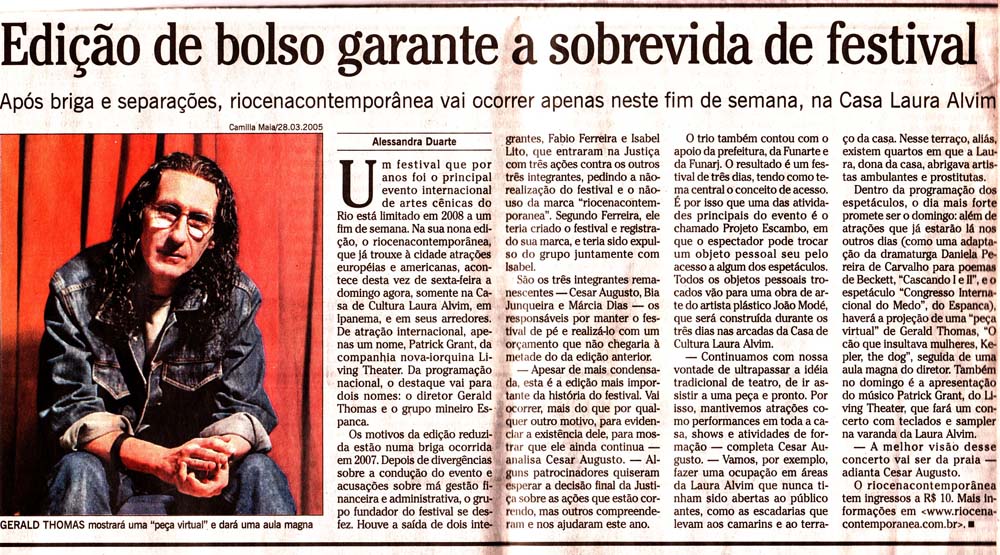
O Globo, Segundo Quaderno, Dec. 10, 2008
It went by in a blur, a steady stream of music that was coming out and onto the streets of Ipanema for the better part of 70 minutes. I pulled every rabbit-out-of-a-hat that I could: live keyboard playing, live mixes of tracks from Bate Man, dance-like mixes of music from Complexo Sistema, music from my theater catalog (it was a theater festival after all) and that meant playing live along with tracks from Eureka! and older pieces, sections of concert works, and especially the Frankenstein-ed real time creations of combining elements of all of these things together into seamless mini-pieces that kept flowing in and out of each other. The people out there on the Av. Vieira Souto would stop and cheer, some danced, and there was guy who I dubbed “my biggest fan in Rio.” Wow, he wouldn’t stop dancing and hung onto every note I played. I needed him badly! The rain had really kept the crowd down so there wasn’t the usual bio-feedback from a public that performers use as a renewable energy source. I just had to keep pulling it out of me, and I did, but man, was I tired afterwards. I was really happy with the show but I admit that I was a little disappointed that Mother Nature didn’t have the concert in her plans that day.
Still, the people at the festival realized that too (it was a blameless situation) and they also realized that I didn’t let the rain dampen my performance one bit. César and the ladies were very, very appreciative and that felt good that they were pleased. There was talk of having me do it again later that week in better weather, and I could have, and I would have, but little did we know then that it was to continue raining for the next seven days!
With the concert over, I packed up and was eating some cheese covered popcorn (pipoca) from a street vendor just when Gerald pulled up in a taxi with his bags to do his thing at the festival before leaving town. I had to go soon and we hugged and I thanked him for everything. I told him to travel well and that we’d be talking as usual, almost everyday, and I’d keep him up to date on how his show and the other events were going. Adriana drove me back to SESC so I could do that night’s performance of Bate Man. During the ride we spoke of astrology (I am not a believer), semiotics, ancient calendars and all sorts of interesting esoterica. She is a very positive and bright spirit and I was lucky to have her be a part of what I was doing. She would play an even bigger role later in the week at my workshops which were to begin tomorrow, Monday. After the Bate Man performance I set my alarm and went straight to bed, ready to hit it again and get ready for the third project of my trip.
Part 2 - The Workshops at SESC - Copacabana
Did I mention that SESC does not have internet access? This became a mantra of mine especially because I had been relying on having one for the preparation of my workshops.
You can read the fine promotional material that was generated below about what the workshops were to entail. An aspect that I was hoping to have available in-between the cracks of my other work during that first week was the ability to download content such as JPEGs and GIFs from a DSL line to make my laptop projections a little sexier and to keep it from being solely talking. That included the ability to augment my research materials and to torrent various audio files (MP3s etc.) to use as musical examples. Well, that also wasn’t in the cards so I had to adapt and, after all, it really didn’t change the core content and purpose of the workshops. I had only hoped to spice it up a little.
Maybe I was a little spoiled from my trip to Sâo Paulo earlier this autumn where, at the Staybridge Suites, they had all kind of crazy wireless for me to use: at my desk, on the sofa, on the bed, wherever and whenever I could think of something to use, someone to write, or something to download. Here in Rio, my only recourse was the internet café around the corner. I had badgered them into letting me bring my laptop and download my email directly from the DSL but it really wasn’t conducive to working the way I like to work let alone letting something download overnight while I slept and other techniques that we all use our homes. I did download some stuff, just the essential things, but larger items and the ability to surf-at-will had to be worked-around.
These workshops were the original component of my work in Rio and that truly got me there in the first place and this was thanks to Gustavo Ariani. The initial emails that I had sent way back in Oct.-Nov. when I was in Sâo Paulo had fully blossomed into this trip and these workshops were the joint sponsorship of his theater school CAL and of the SESC – Rio de Janeiro, the larger regional SESC that contained the one in Copacabana. They took place in a second floor conference room complete with sound system, video projection, and whatever other peripherals I needed and in my case that meant coffee-on-demand.
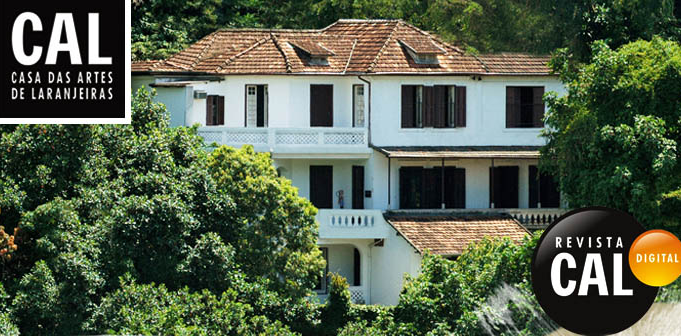
CAL – Casa das Artes de Laranjeiras - Gustavo Ariani's theater school in Rio and workshop sponsor
I spent all of Monday morning and afternoon, the day after the Ipanema concert, arranging my notes and digital content for the 5:00-8:00 session. The workshop had an enrollment of over 30 participants signed up but only a little over 20 showed up, mostly due to the rain which continued in full force outside. It was explained to me that the cariocas, the people from the Rio region of Brazil, are very much like cats and will disappear at the slightest sign of rain. I guess that they’re so used to perfect beach weather that anything other than that really throws them off. How different they are from the landlocked Paulistas a five-hour drive/one-hour flight away.
At five o’clock we were all set up. What a bunch that showed up. Gustavo’s concern that my workshop may have been too music-oriented but we pulled in an even mix of actors, dancers, musicians and people that were simply curious and wanted to learn a few things. I was provided a translator but most of those who attended had some working knowledge of English. Most. For those that didn’t, the live translation helped and we quickly fell into a routine where the participants themselves would speak up and cross-translate for each other. It was a fun process though it did add on time onto what I wanted to cover in each session. My only danger was going too fast and speaking in chunks of info too large to translate effectively. That note taken, I was refining the presentation on my feet every second, adapting it for the individuals at hand as opposed to a generic mix of imaginary people which they had been up until this point.
How great it was to have a captive audience and be able to fully explain my origins and work and everything that had led me up to this moment in the classroom. I was happy to fully explain my geographic place of birth and upbringing, Detroit, Michigan a.k.a. The Motor City, Motown, etc. and it’s unique placement across the river from Canada and the influence of the Canadian Broadcasting Corp., shows from the BBC, and how in many ways it placed us closer to what was going on musically in Europe, more so than the bigger coastal cities on the East Coast like NYC.
I listed the litany of musicians and performers to come out of that system and they were amazed at its length. I stressed the fact that even classically trained composers like me and others from Detroit have never, ever had issues with incorporating the popular music that surrounded us into our own works, as a general note, and way before other scenes in America adopted that aesthetic. Also, as an industrial city and the birthplace of Techno, Detroit musicians, serious or popular, also took more easily to making music with machines i.e. sequencers, drum boxes etc. and using them as legitimate tools of musical expression without sacrificing feel or funkiness. I’m sure that other Detroit-born composers like friend Randy Woolf for example will back me up on this.
I then went round-robin with the participants and found out a little about them, their name, discipline, what brought them here, what they hoped to get out of the workshop. That was very helpful to do in further tailoring the sessions ahead and maximizing the group itself as a resource. I found out that many of them were very skilled and knowledgeable about either music and/or theater so that meant that I didn’t have to cover the basics so much as that I could move beyond that into some more advanced and more interesting levels of ideas and concepts.
Then it was time for me to provide some historical background and it was given with the caveat that it was not meant to be all-inclusive but merely the line which I chose the draw, as it applied to the workshop at hand, and mainly that it drew from my own personal experience and formation. As advertised, I went back 100 years to the Marinetti’s Futurist Manifesto and to Russolo’s The Art of Noise. From there we went through the Dada movement, the Surrealists, and stopped on Antonin Artaud where I explained his love of the Balinese gamelan, its non-textual forms and the gamelan ensemble itself as a community music and as a model for incorporating actors/dancers into musical compositions. I played examples of my own gamelan work, track by track, and showed them how a piece of it is built up. I also explained how this percussive sound influenced John Cage in his prepared piano works, dissected his CREDO: The Future of Music and how he, Artaud and the Epic Theater of Brecht all converged, on so many different levels, in the works of the incipient Living Theatre in 1950s New York City.
Whew! That was a lot of ground to cover. We closed out that session with a discussion about my recent work and played them relevent examples of my music. What a great group they were and how glad I was to have it go so well. All that and there was no performance tonight. I looked forward to resting, relaxing and getting myself centered again on what would be my first real break since arriving nine days ago.

On Tuesday I got a surprise phone call from Dani Visco. Rainy as it was, she asked, "Did I want to get out of Copacabana and go for a drive south of the city?" Sure! I needed a change of scenery badly having only seen theaters and hotel rooms since I arrived. We took a long and twisty mountainous drive down the coast to Grumari, an undeveloped and almost deserted beach, past the suburbs, favelas and wildlife preserves south of Rio. The beach was covered in roses and religious talismans that the locals leave as offerings to the ancient sea gods of Brazil. Peaceful beach dogs wandered around and only a few other people where there to witness all that beauty in all that grayness. Later, back in Rio, we had a Japanese dinner, a refreshing change from the rodizios. I prepared a little for the next day’s workshop but mostly recharged my batteries for more work ahead.
Wednesday brought us yet another rainy day. The cariocas were really freaking out now. Not only were they ill-equipped for this non-beach-like weather but it was the beginning of the tourist season and everything was empty. That was no skin off of my teeth since everything I had to do was indoors.
For today’s workshop we had some special visitors. Writer/director Ruy Filho had taken the bus up from Sâo Paulo that morning with three actors from his Cia. Antro Exposto, Guilherme Gorski, Diego Torraca and Raianni Teichmann. It was good to see friends and to practice my bad Portuguese in the more sing-songy Italian-influenced Paulista accent of which I was much more familiar with and can just hear better. The day before, just before going to the beach, I had received a special delivery of the complete Complexo Sistema DVD which I edited and dropped better audio into to show to the workshop at today's session. Up until then I’ve only had footage of the trailer length version we made.
I began the workshop by making the necessary introductions and Ruy and I went back and forth describing from the very beginning how our work came into being: an introduction from Gerald, months of garbled emails translated via Babelfish, rehearsal videos for me to work with posted by Ruy on YouTube, my arrival in SP and the rehearsals which were recorded into Reason 4.0 and their subsequent refinement and temporal lock into Ableton LIVE 7 and their orchestration, the interactive quality of the performance, and of my handing the reigns over to Ruy for running the show after I returned to NYC. That pretty much sums up how I’d been working all autumn and how I managed to put out four scores in as many months. It went great and it was also good to raise the Portuguese content of the classes, no translation needed. Also, I was very happy for Ruy and Co. that they were able to meet Gustavo and Beatriz (Bia) Radunsky, the director of the SESC –Copacabana because it meant a foothold for them in getting their work into the Rio system in the future.
It is interesting to note that the two pieces that I created for Brazil this autumn, Complexo Sistema and Bate Man, different as they may be, share a common feature in their creative processes though for very different reasons. That feature is in the way that talking about the work was kept to an incredibly bare minimun and the music and sound itself, all tried out in the theater, did the speaking for itself. With Gerald, the reason was because we knew each other's needs and aesthetic so well that there was no need for many words. In Ruy's case, we both were at a loss for each other's native tongue. That meant that we had no other recourse than to speak through the language of theater itself. Any ideas we wanted to share had to be through sound and movement, music or lights. Only then could we nod approvingly at each other when something worked or in the case of the Brazilians, give a hearty "thumbs up." I can easily see that in all my future theater work (or any other multi-disciplanary venture) that I have to find ways to keep that kind of flow. Just another reason to be happy that our musical technology has caught up with old school acoustic spantaneity, that is: if you know what you're doing, have the analog experience, and come prepared for any eventuality.
Adriana had showed up and made video of the entire workshop. I was/am so grateful for that. I haven’t gotten copies of it yet but when I do, there’ll be plenty of workshop content to post (that and the concert footage too!).
The rest of the workshop dealt with determining a workshop project of our own into which we could apply the theatrical music techniques I had been imparting. We had decided at the last session that we would find local stories in O Globo and mash them up into a scenario to which we could score. The more musical attendees had brought their instruments (electric guitars) and we chose three stories that, when spliced together from real news items, went something like this: an eldery mother cannot afford the adult diapers she needs so her son, a rapper, decides to go out and steal some, he robs a local drugstore, is chased by a policeman, they end up shooting each other when distratcted by the mother, the woman takes the diapers and runs off as police sirens are heard in the distance (really, every element came from that day's newspaper).
OK, so Shakespeare it wasn't, but it did provide us something to work with and afterall, the story was not the point of the workshop, but the sound design. Plus, we had a few laughs along the way. We cast the scenario with the available actors and dancers and roughed it out musically with me at the keyboard and others at their guitars scene by scene, all the while recording the takes into Reason 4.0 so we could find an average timing/duration on each of them. That done, it brought the second workshop to its conclusion. Everyone was excited that we were actually making something together. Me too.
That night, I took Cia. Antro Exposto to my favorite (and cheap) rodizio in the ‘hood where we caught up and traded stories about the goings on in SP before they all went to Raianni’s uncle’s house in Rio to crash for the night.
Thursday was another “day off,” at least the mornin and afternoon were, since the second week of Bate Man performances started up that night. Instead of squandering another rainy day with another field trip, I decided it was in my best interest to totally slack-off which I did with aplomb. Reading, writing and sleeping filled my morning and afternoon save for the usual trips out of the room for internet and food. One additional trip: to the liquor store to buy some sake for the post-performance Japanese-themed party at the Cia. dos Atores space in Lapa that night. They’d have the food and rice wine was the price of admission. I had gotten Ruy & Co. invited as well and made sure that they got sake too before the performance of which they attended.
The performance went well or at least I mean that I was happy with the improvements I had made in the multi-layered guitars in the score. In between the cracks of everything else in my schedule I was able to, over a period of days, go in "with a microscope" and tighten up the groove. Recording multitracked guitars in a hotel room can be less than scientific when being as extemporaneous as it was, so, with some patience, I was able to shuffle around the tracks until they all fell "in the pocket" and sounded like an ensemble instead of being takes done at different times and stacked one on top of the other.
The party was great! It probably was, and also sad to say, the social highlight of my trip. The Cia. had people from the local Japanese restaurant upstairs working in the kitchen preparing all kinds of food and bringing it down on trays in regular intervals. I was able to pour my water into the traditional box-like sake cup so, all evening long, I wasn't pestered with the usual, "Why aren't you drinking? Aren't you having fun?" Well, I was having fun actually. I really got to speak with all of the people with I had been working all week but didn't have time to hang with. I really got to know César Agusto and learn more about the Cia.'s history. I mean, it was their 20th anniversary that got Bate Man created. Good folks, good times and I even threw in a little dancing of my own when everybody was too wasted to notice.
Eventually, Ruy and the gang had to get back to the uncle's house because of the early morning bus departure back to SP. It was great that they came and that they also got to meet the people in the Cia. dos Atores too. I'm glad that Complexo Sistema in opening again at a different theater in SP and will run from January to March and that my artistic presence can continue in Brazil until I return again hopefully in the spring. With them on their way back, it was just a matter of time before we took a poll and I found two other takers for a cab back to Copacabana.
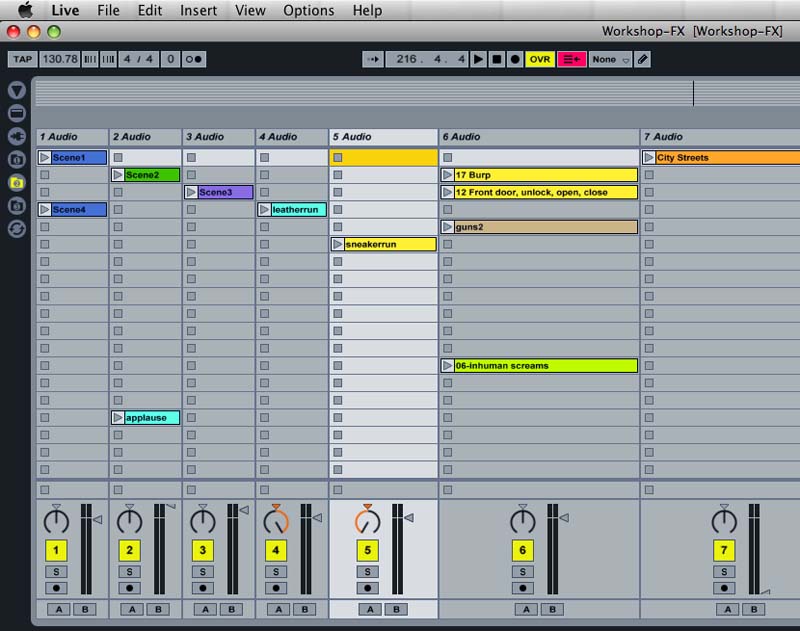
Friday was here and it was the last day of the workshop. After my usual morning routine, which at this point included my daily phone call from Gerald so I could give him any updates and news, I went back to the room to edit our work from the previous session and to create recording templates so we could work as quickly as possible.
A handful of the key musicians in the workshop were going to be late today. They had a gig earlier in the afternoon and were, no surprise in Brazil, stuck in traffic. This included my translator Giulio who is their singer. No problem. It gave me time to bring the historical part of the workshop up to the present. I picked up in the late 1950s where I had left off and brought it into the Sixties with Mabou Mines, The Wooster Group, Robert Wilson/ Philip Glass and the rise of Performance Art and other downtown genres. I made the point that we here in the Americas, North and South, being so far from a total gravitational pull of Europe, had been able to successfully begin the trend of combining “high” art and “low” art, a Post-Modern feature of the avant-garde that permeates almost all work done by any artists worth their salt now in the 21st century. This of course includes the work of Gerald who has had no problem with the meeting on the stage of classical characters from theatrical history with a sudden appearance from, say, Batman or Donald Duck, if it truly helps the narrative. The score the Bate Man itself features all kinds of “classical” and “contemporary” music right along the side of good old rock ‘n’ roll, punk and disco.
The last technical lesson I gave them was that on the use of sound effect libraries and how to implement them for rapid use in sound design for theater. That was fun and, like the TV chef, I already had a number of sound FX that were applicable to our crazy scenario ready to go, just like how the chef takes the finished dish out of the oven to save on time. We still had to agree as to what worked best and I let them make those choices.
By now the musicians had cut through traffic and had shown up. I got them all plugged into the sound system and we recorded music for each of the sub-scenes as determined by the templates we created last session and which I had edited-down for today. We got it done but time was running short. All I needed now was time to throw all of these elements into a LIVE 7 session so we could run it with the actors. This I had to do alone but my laptop’s screen was being projected behind me so they could see what I was doing as I explained each move aloud. Some people started talking during these intervals and it got a bit hard for me to concentrate on what I was doing and so I had to keep telling them to keep it down. I couldn’t blame them, at least the actors and the dancers in the bunch. Editing audio isn’t exactly a spectator sport but I got through it and was ready to go.
Adriana was there again, shooting video all the time. I wonder how crazy it’ll be to see when I finally get the footage. I was working away like a mad man but, as I explained, “it’s all about making the deadlines.” And so we did.
In the last half hour of the workshop, Gustavo gave me a stack of certificates I was to sign for each of the attendees (see below). I did this between the cracks as usual but what was most important was that we run the piece a couple of times for practice. This we did and when we all felt ready, we did it once ‘for real” and counted that as our performance. It always amazes me but, it came together, everybody was happy, we had fun, and most important, we all learned and grew during these nine hours spent together. Having developed and refined a format for this kind of work, I look forward to doing it again as soon as possible.
As I thanked everyone individually and gave them their certificates, Gustavo announced that as a bonus that they would have free admission to see Bate Man as a way of seeing their teacher in action in a real show. Many came who were free and the rest came on the weekend. I felt very good that I made the students and the organizers feel that this was a worthwhile experience. Something to consider and pursue when having something else to offer the presenters who get me out of NYC and on the road.
The performance that night went on without a hitch. With the workshop successfully behind me, I had free time hang out at the Café Pierrot on the corner of Av. Santa Clara with the crew from Bate Man and kick back a little, eat some damn decent pub grub, and have a few laughs. A nice change of pace to bring my second week to a close.
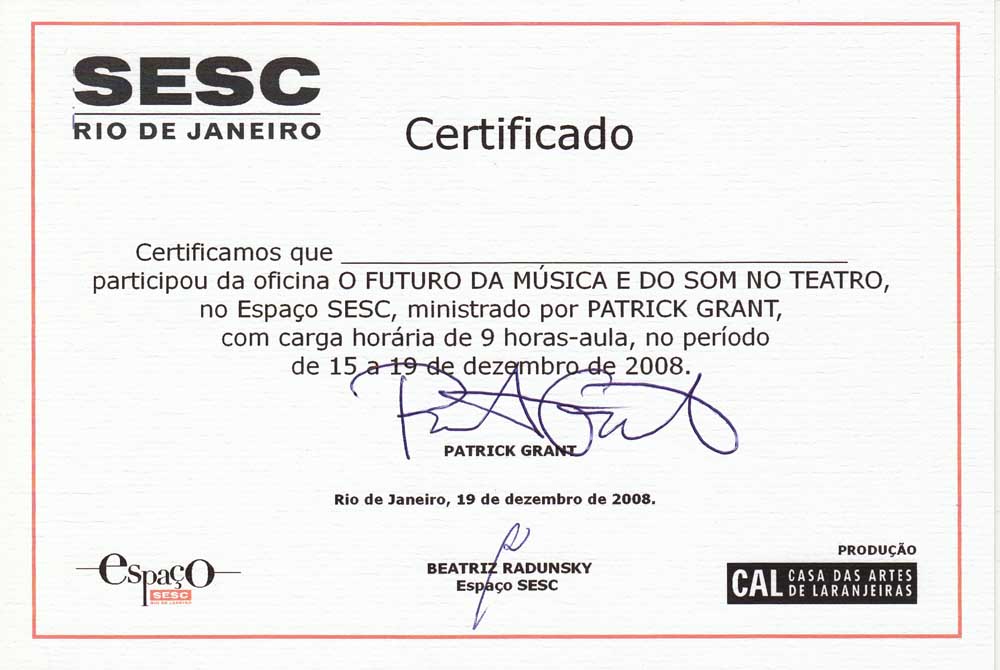
The certificate that the attendees of my three day workshop on The Future of Music & Sound in the Theater were given
Week 3:
The third Saturday arrived and I was a short-timer now, my flight to go back to NYC set for late Tuesday night, Dec. 23rd.
There were only two performances of Bate Man left to do, finish up any contractual business with the producers, and prepare the music and cue sheets for handing over to the Cia. dos Atores.
One thing that I've always liked about performances outside of the USA is that each country has pretty decent legislation when it comes to the rights of the composer in regards to theatrical works. For instance, above and beyond any fees for the actual creation of the work, the composer is guaranteed a certain percentage of the box office. In Brazil for example, it is 5% of the gross ticket sales. Not a lot but, should a show go on tour and get multiple performances, it does add up. In the USA, anything that is staged - theater or dance, is considered "Grand Rights" and that is let up solely to the composer and producers to hack out for themselves. In other words there are absolutely no enforceable guidelines in place so that often means that the composer, in smaller productions, will more than often receive nothing off the door. A shame really.
Now with all but Bate Man winding down, it was starting to dawn on me that Christmas was right around the corner. It was so hard to tell in Rio with the palm trees and, at least near the beach, not the plethora of decorations I was used to seeing back home though they were there. It just didn't register. It was hard to sort them out from the usual festive bric-a-brac that seems like it was probably there all year round, beachy stuff, strings of flashing lights and other baubles not necessarily related to the Nativity. That was just my take on it. When I brought it up with the Brazilians they told me it's there if you know where to find it and if I were to visit one of their shopping malls, I'd see everyone out in full force just like I would in any other large Western city. It must be that the beach culture was dominating everything from where I was situated.
I didn't have much interest on that third Saturday to venture into any areas of intense commerce. I just did my usual and begin writing down a coherent cue sheet of Bate Man to pass on to Rodrigo from the Cia. It was taking a while because I was trying to be so thorough and would be, by the time I finalized my mixes and LIVE 7 sessions, a two-day job.
That night the performance came and went and I went out to dinner with Dani Visco, Claudia Dorei and Claudia's girlfriend, another Claudia who is an actress on a telenovela. Claudia is the DJ/musician who ran the sound for Gerald's Kepler, the Dog in SP a month before. We pretty much talked shop and traded info on sound gear.
The day of the last performance arrived and I finished the cues. It was the first semi-sunny day in a long time. I even took a walk to the beach! I began writing and sending thank you emails to all in Rio who were involved as well as, for lack of cards, printing up slips of paper with my contact info to give out to the new friends I made during my stay. After the show, it was a good closing night house, we had another hang at the corner cafe and traded info, thanked each other and wished each other Feliz Natal. I had passed on the audio files and cue sheets to Rodrigo so that was the finalization of that particular stint. I would hope that Bate Man gets toured around Brazil in 2009 but that is still in formation.
The last two days were simply packing and tying up loose ends. This included getting notarized contracts and my split of the door from the producers, DVDs of the show for Gerald and a personal thank you card with chocolates form Olinto, a trip to the studio of Rodrigo and Lucas (very cool), and a hang at Adriana's house in the afternoon/early evening with her family.
The best close to my stay in Rio was, after checking out of SESC, was getting picked up by Gustavo Ariani and hanging out at the studio in his house for the afternoon. Before becoming director of CAL, Gustavo wrote a lot of music for theater. We listened to a score of his from a production of Dracula (winds and percussion), children's music on early MIDI keyboards, and many other pieces, all good. We sight read Bach on his piano, watched a video of Bernstein rehearsing The Rite of Spring, and all sorts of stuff that musicians like to do together. What a great guy he had been to me the entire trip. I only hope that we'll be able to do it again some day soon.
I was glad that he helped me at the desk at the airport. With one too many bags, a keyboard, and most of my luggage filled with all kinds of electronic equipment (I would love to see that X-Ray), one never knows how you'll be treated. The desk person in NYC almost charged me an extra $125 for being 2 pounds overweight. This young lady, with the help of Gustavo, let it slide and really took her time getting everything of mine checked. That was a great relief because I always have a semi-heart attack traveling alone, continent-to-continent, with all that stuff. A sad goodbye with Gustavo and I was on the plane for an 11 hour filght.
Arriving back in NYC, the morning of Christmas Eve, could not have been more different that the place I just left. The solstice had passed so, while Rio was just beginning summer, here was my city in winter. Cold, snowy, and everybody running around getting in their last minute shopping done. Ho ho ho - indeed. I had exactly 10 hours to get into the holiday spirit...
And I did.
Happy New Year!!!